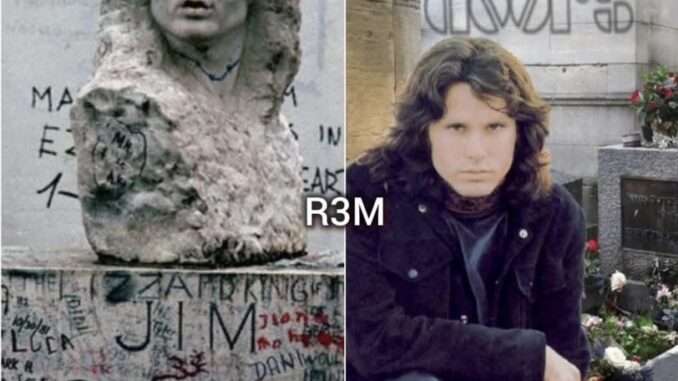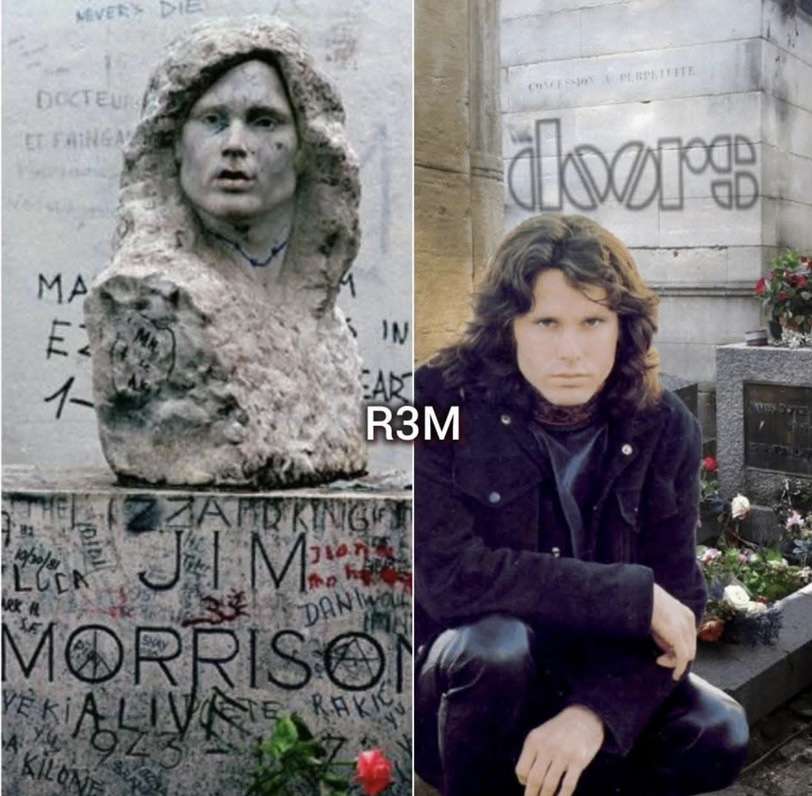
After nearly four decades shrouded in mystery, the long-lost marble bust of Jim Morrison, legendary frontman of The Doors, has been recovered, according to confirmation from French authorities. The statue, which once crowned Morrison’s grave at Paris’s iconic Père-Lachaise Cemetery, was stolen in 1988—vanishing almost as suddenly as the singer himself did in 1971.
Now, 37 years later, the stolen memorial has resurfaced, bringing both relief and nostalgia to fans around the world.
A Tribute to a Fallen Star
The heavy marble bust was sculpted by Croatian artist Mladen Mikulin in 1981 to commemorate the tenth anniversary of Morrison’s untimely death. Made from solid marble and weighing a substantial 128 kilograms (about 282 pounds), the bust was a serene, contemplative likeness of the singer, capturing the poetic and troubled soul that fans had come to revere.
Placed atop Morrison’s simple gravestone in Père-Lachaise, the bust quickly became a focal point for fans visiting the singer’s resting place. It was more than a statue—it became a 
But in 1988, the bust disappeared under mysterious circumstances.
The Disappearance
The theft of the statue sparked headlines and rumors throughout the music world. One of the most persistent stories suggested that two determined fans managed to steal the 128kg sculpture by strapping it to a scooter and slipping out of the cemetery under the cover of night. While the story has always seemed far-fetched, it reflects the almost mythical status the statue—and Morrison himself—held in the public imagination.
The French police launched an investigation, but the case went cold quickly. No credible leads ever emerged, and the statue remained lost. Over the years, replicas appeared, including another bust made by Mikulin in 1989, but none carried the same emotional and historical weight as the original.
The Discovery
The circumstances of the statue’s recovery have not been fully disclosed, but French authorities confirmed this week that the bust has been located and identified as the original 1981 sculpture. According to the police, it was found in the possession of a private collector who had no idea the piece had been stolen property.
An official from the Paris Police Prefecture said, *“After a tip-off, we were able to confirm the sculpture’s authenticity through material analysis and comparison with archived images. We are now working with cultural heritage authorities to determine the appropriate next steps.”*
It’s not yet clear whether the statue will be returned to Morrison’s grave or placed in a museum or archive for preservation.
Fans React
News of the recovery has sparked emotional reactions across fan communities online. Many expressed joy and surprise that the bust—presumed destroyed or hidden forever—had resurfaced. For longtime fans who have visited the grave over the years, the absence of the statue was always a reminder of how easily history can be lost.
Luisa D., a lifelong Doors fan from Madrid, commented, *“I visited Jim’s grave in 2005. It was peaceful, but I remember feeling something was missing. That statue was part of the soul of that place. To know it’s still out there means something.”*
Others raised questions about how the statue went unnoticed for so long and whether security measures at Père-Lachaise have improved since the theft.
The Legacy of Jim Morrison Lives On
Jim Morrison, who died in Paris in 1971 at the age of 27, has remained a figure of fascination in music and pop culture. As lead singer of The Doors, his poetic lyrics, baritone voice, and magnetic stage presence helped define an era of rock that blurred the lines between rebellion and transcendence.
His grave has become one of the most visited in Père-Lachaise, alongside those of Oscar Wilde, Edith Piaf, and Frédéric Chopin. Over the years, it has been adorned with flowers, graffiti, and mementos—testaments to Morrison’s enduring influence.
With the recovery of the statue, many hope that a piece of that legacy can now be restored to its rightful place.
What Happens Next?
While authorities have not yet confirmed if or when the bust will return to the grave, artist Mladen Mikulin has expressed openness to seeing his original work reinstated. In a recent statement, he said, *“It was created in memory and reverence. If it can return to that sacred place, it will be like bringing a soul back home.”*
Whatever the final decision, the return of Jim Morrison’s long-lost statue feels like a moment of healing—a strange and poetic chapter in the continuing story of one of rock’s most enigmatic icons.
And for fans, it’s another reminder that while legends may fade, they are never truly lost.
Leave a Reply